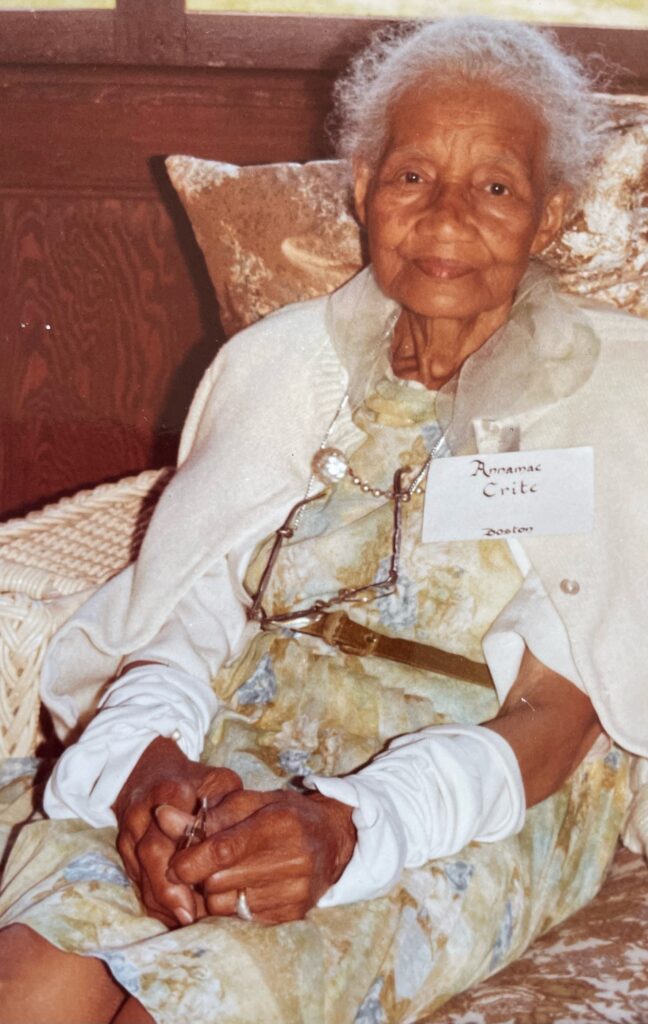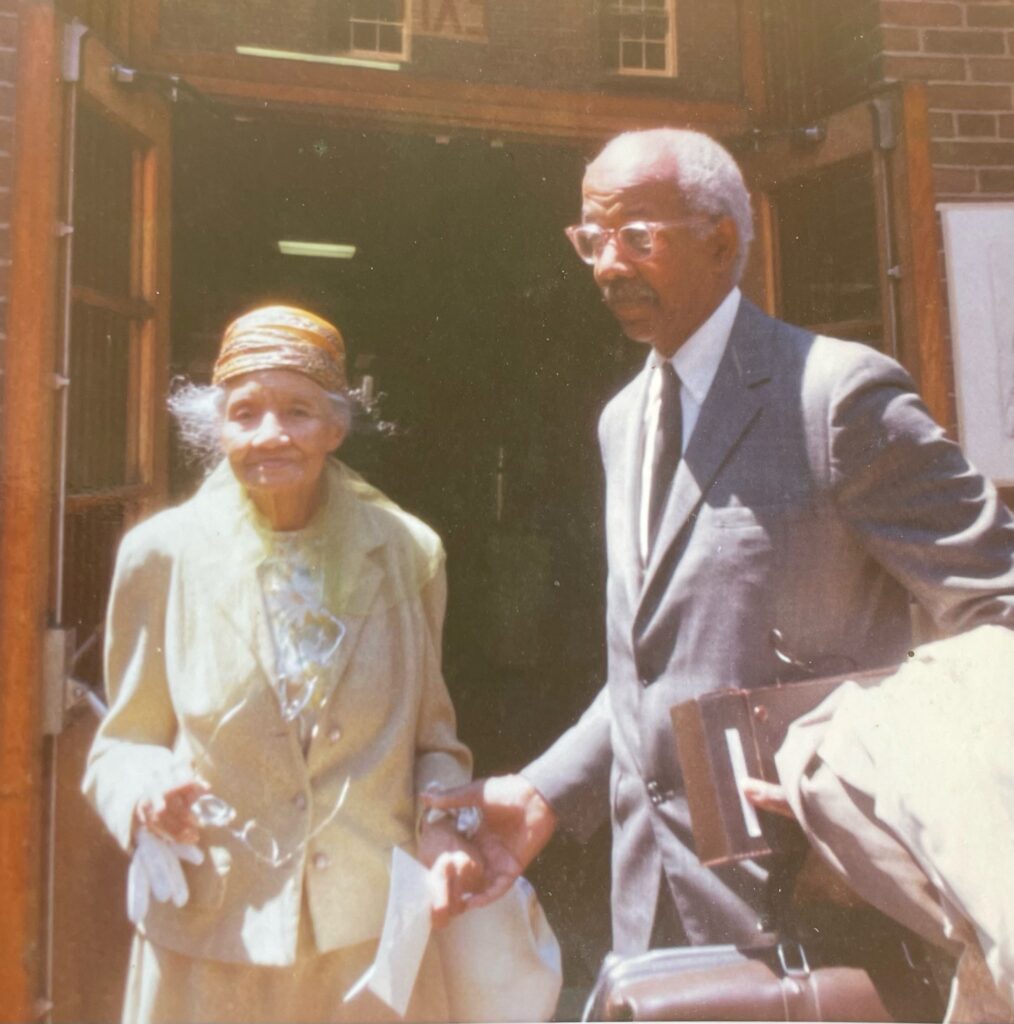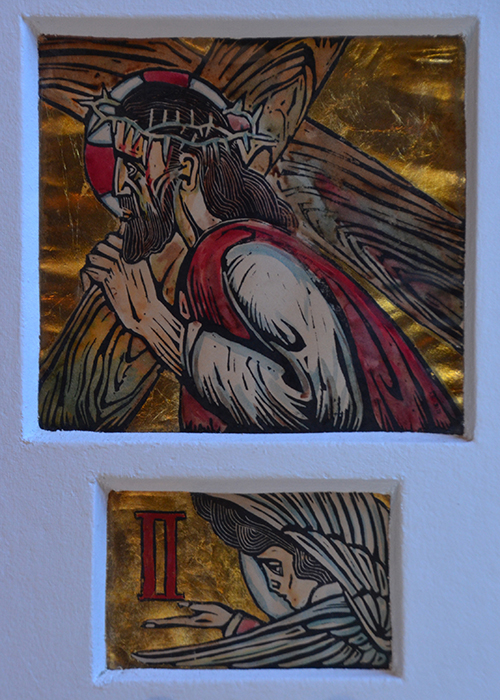Our Featured Paradise Companion: Annamae Palmer Crite
You Never Know What Will Turn Up in the Archives
Our Featured Paradise Companion
Annamae Palmer Crite
Born May 11, 1891,
Admitted into SCHC in 1946,
Died March 24, 1977
Written by Cynthia D. Pape, Archivist, SCHC
Edited by Anne C. Moore
She moved like a doe. To those Companions who were familiar with Annamae Palmer Crite, one hardly ever heard the footsteps that bore up her aristocratic frame. She was known to have the manners of a Victorian lady and a “gorgeous speaking voice.” Annamae’s capacity to learn, her colossal faith in God, and her determination to serve Him first, no matter the circumstance, won her an enormous amount of admiration.
Annamae Palmer’s life began on May 11, 1891, in St. Peter’s, Pennsylvania. The details are hazy at best. There is no mention of a mother. She lived with her father in Germantown, Pennsylvania, and faithfully attended Baptist services with him on Sundays, and Zion Methodist services when she visited her father’s half-sister, whom she treasured as an aunt. Summers were spent at a Baptist camp, singing spirituals, and attending worship services. Annamae loved it all.
School was another joy. Curiosity and a razor-sharp intelligence made Annamae a champion question-asker. The local Episcopal Church offered classes outside of regular school and the more Annamae learned, the more she wanted to learn. Nothing would stop her: Not even marriage. Not even becoming a mother.
At age 19, Miss Annamae Palmer married Mr. Oscar William Crite in North Plainfield, New Jersey, in June of 1909. Mr. Crite was employed in business, and he pursued opportunities with mighty determination. Just after the birth of their son, Allan Rohan Crite, in March of 1910, Oscar, Annamae, and baby Allan headed north to Boston, Massachusetts. Annamae couldn’t have been happier. She had long heard about Harvard University, and it was the first place she visited after the family settled in Boston’s South End. She would find her faith community close by the revered school at St. Bartholomew’s Church.
Not only would she eventually attend Harvard, but she also determined that her son would too. According to an article written by Paradise Companion Jo Gillespie, and a stack of handwritten notes from Paradise Companion Lee Beatty, the young wife and mother would devote hours to her church altar guild at St. Bartholomew’s, then spend any shred of spare time left over getting to know every nook and cranny of Harvard University. The Fogg Museum and the glass flower exhibit took her breath away.
Annamae was the first African American to enroll in Harvard University’s Extension School taking one academic course at a time. Annamae also enjoyed reading privileges at the Boston Atheneum and she would come home weighed down with books. She attended classes in zoology, botany, literature, poetry, art, and Shakespeare. There is a written account of Annamae walking to classes hip-high in snow during a merciless New England Nor’easter because the buses couldn’t run in that much snow.
The first dean of the Harvard Extension School, John Adams vividly remembered Mrs. Crite attending class wearing white gloves, which she did not take off, even to take notes. But before she went to her class, she attended Holy Eucharist with the Society of St. John the Evangelist (SSJE). Following several years of study, Annamae gained enough credits to claim an undergraduate degree from her beloved Harvard. She never did. There is no explanation to be found as to why. Allan would complete his studies at Harvard Extension School and claim the parchment that said so.
Altar Guild was Annamae’s specialty. Using her enthralling voice, Annamae would train altar guild volunteers with great solemnity, explaining the function and meaning behind every kind of linen. “You could have heard a pin drop,” said a St. Bartholomew’s parishioner. The linens had to be correct, crisp, and folded with scientific precision. Her linen expertise carried over to the Society as well. Everything in apple pie order. Companion Winnifred Hulbert, now in Paradise, said that Annamae was an expert in ecclesiastical embroidery. After becoming a companion in 1946, Annamae repaired the Alleluia superfrontal in the Adelynrood Chapel. She never spent the night at Adelynrood. Her responsibilities at home to husband and son kept her from doing so. She would spend days by herself in the chapel tending to the altar linens as happy as she could be.
Annamae’s love for literature, arts and sciences was a source of immense pride for her husband Oscar. Seeing the gifts his wife and son had for art and writing, Oscar would come home from work with unused ledger books and pencils for Annamae which she guarded jealously. She longed to become “a poetess.” But little Mr. Allan would reach for those pencils and draw. And draw. And draw. “When he wasn’t eating, he was drawing,” said his mother. Annamae showed him how to draw circles, squares, and triangles and he took it from there. As Allan’s drawing became more sophisticated, his teachers strongly encouraged him to attend the Boston Children’s Art School where he easily won a seat. Heading into his teens, Allan’s oil paintings of street scenes depicting everyday life in his South End neighborhood were vibrant with color.
Pain and loss would come. Beloved husband and father Oscar was felled by a stroke in 1929 making Annamae the breadwinner of the family. There was not much bread to be won. She worked outside the home and took care of her husband until he died in 1937. During that time, she cleaned office buildings in downtown Boston and worked as a domestic servant for a wealthy family. She insisted that Allan finish his education before getting a job. Allan also tenderly looked after his paralyzed father and became a drafting engineer at the New Boston Naval Shipyard in Chelsea Massachusetts. That job would provide him with a regular paycheck and an inadequate pension in later years.
Both mother and son shied away from public recognition. Neither enjoyed intrusions into their private lives. Edward Clark managed to coax the duo into giving him an interview in 1976 over a period of two days. He was a professor at Suffolk University who had gained notoriety for his work in building a celebrated collection of African American literature at his university. By this time, Allan Crite had received many honors for his art that showed life as it was on the streets of the South End. The Crites rejected the often-portrayed life of a “Jazz Negro” hanging out in frowzy, smoke-filled night clubs. Such images rankled Allan. Mother and son considered this to be an undignified and cliched depiction of Black life in early twentieth century Boston. Allan painted what he called “real life” in Boston street scenes with people of color milling about the streets, going to work, to school, to the grocery store, washing dishes, “like human beings.”
Mother Crite remembers that everyone got along with no racial tension or resentments. This sentiment gave this writer pause. Surely, the Crites could see the inequality between White Catholics, Black people, and Irish Americans that would eventually lead to the city’s anti-busing riots in the 1970’s. According to Annamae, there was no need for such ugliness. “We all got along so well. Not like today.” Annamae recalled days as a young girl visiting her Aunt Serena who had bought a large house in Atlantic City with money, she had saved from working on a plantation. “…but mixing in those days wasn’t like it is now. No one thought anything of it. Your white employer in Philadelphia might be a weekend visitor in Atlantic City. Class distinction didn’t exist.” Both mother and son did not let the color of their skin interfere with their ambitions and were completely at ease moving in all circles of society. After her son had gained accolades for his paintings and drawings, Annamae cited an occasion when Allan was lecturing at the Gardner Palace Museum in Boston’s Fenway neighborhood. Annamae came to listen and ended up sipping tea with the owner and benefactor, Isabella Stewart Gardener. She observed the granddame of Boston society being possessed of an aura of melancholy, which Annamae attributed to the loss of her only child, Jack.
As Annamae advanced in years, Allan’s salary did not. He hated exhibiting his art, never thought about money, and couldn’t have cared less if the phone service were cut off or utility companies were snapping at his heels because of overdue payments. He cared about his art and his mother, his mother, and his art.
Occasional sales of his artwork, irregular honoraria, and a modest pension did little to prevent the Crite home on Dixwell Street from significant deterioration. Both Allan and Annamae were destitute and didn’t seem to mind one bit.
Annamae died in March of 1977 at the age of eighty-six. Allan would eventually marry Jackie Cox in 1993. The house on Dixwell Street had to be sold because Allan and Jackie couldn’t afford to keep it up. In time the house was torn down to make way for progress. They moved to Columbus Avenue and not only set up housekeeping but opened a museum and a foundation: The Annamae and Allan R. Crite Prize for Academic Achievement and Artistic Excellence.
The Society had the honor of being presented with Allan’s stations of the cross, with Christ being depicted as a man of color. They are cherished.
There were three things Annamae loved most in this world: the Episcopal Church, Harvard, and the Society of the Companions of the Holy Cross. “Oh, and Allan, of course.”

Annamae at Adelynrood.

Annamae and her son, Allan.

Allan Rohan Crite’s Station of the Cross, II
C.D. Pape
April 20, 2023
Dorchester, MA






